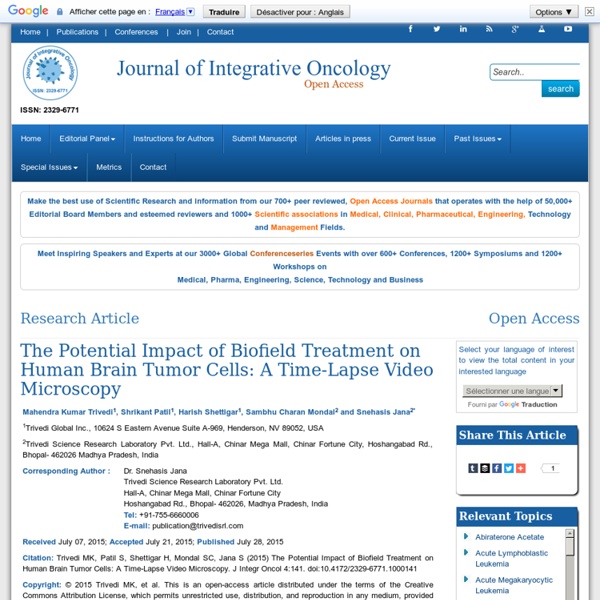Evaluation of Phenotyping and Genotyping Characterization of Serratia marcescens after Biofield Treatment
Currently, many microorganisms have been acquired the resistance to number of antibiotics and other antimicrobial agents, which were effectively used earlier to cure a microbial infections. The antimicrobial resistant microbes (including bacteria, viruses, fungi, and parasites) can survive in antimicrobial drugs therapy. Therefore, regular treatments are ineffective. The frequent and improper use or misuse of antimicrobial medicines accelerates the emergence of drug-resistant microorganism, which was further spread by meagre infection control and poor sanitary conditions [1]. Serratiamarcescens (S. marcescens) is a rod-shaped Gram-negative bacteria, belongs to family Enterobacteriaceae. It is a facultative anaerobic bacterium that can grow in presence and absence of oxygen at temperatures 30°C to 37°C.
The Effect of Biofield Energy on Thymol & Menthol.
Abstract Thymol and menthol are naturally occurring plant derived compounds, which have excellent pharmaceutical and antimicrobial applications. The aim of this work was to evaluate the impact of biofield energy on physical and structural characteristics of thymol and menthol. The control and biofield treated compounds (thymol and menthol) were characterized by X-ray diffraction (XRD), Differential Scanning Calorimetry (DSC), Thermogravimetric analysis (TGA), and Fourier Transform Infrared Spectroscopy (FT-IR). XRD study revealed increase in intensity of the XRD peaks of treated thymol, which was correlated to high crystallinity of the treated sample.
The Potential Impact of Biofield Treatment on Human Brain Tumor Cells
Open Access o u r n a
An Effect of Biofield Treatment on Multidrug-resistant Burkholderia cepacia: A Multihost Pathogen
*The embed functionality can only be used for non commercial purposes. In order to maintain its sustainability, all mass use of content by commercial or not for profit companies must be done in agreement with figshare. Description
An Impact of Biofield Treatment on Glioblastoma Brain Cells
Citation: Trivedi MK, Patil S, Shettigar H, Mondal SC, Jana S (2015) The Potential Impact of Bioeld Treatment on Human Brain Tumor Cells: A Time- Lapse Video Microscopy. J Integr Oncol 4: 141. doi:10.4172/2329-6771.1000141 Page 4 of 4 J Integr Oncol ISSN: 2329-6771 JIO, an open access journal Volume 4 • Issue 3 • 1000141
Thermal and Physical Properties of Biofield Treated Bile Salt and Proteose Peptone
Abstract Bile salt (BS) and proteose peptone (PP) are important biomacromolecules being produced inside the human body. The objective of this study was to investigate the influence of biofield treatment on physicochemical properties of BS and PP. The study was performed in two groups (control and treated).
Characterization of Physico-Chemical and Spectroscopic Properties of Biofield Energy Treated 4-Bromoacetophenone
Characterization of Physico-Chemical and Spectroscopic Properties of Biofield Energy Treated 4-Bromoacetophenone American Journal of Physical Chemistry Volume 4, Issue 4, August 2015, Pages: 30-37 Received: Sep. 19, 2015; Accepted: Sep. 30, 2015; Published: Oct. 16, 2015 Views 3435 Downloads 56 Authors
The Potential Impact of Biofield Treatment on Human Brain Tumor Cells: A Time-Lapse Video Microscopy
Title: The Potential Impact of Biofield Treatment on Human Brain Tumor Cells: A Time-Lapse Video Microscopy Select license:
Thermal, Spectroscopic and Chemical Characterization of Biofield Energy Treated Anisole
Abstract The objective of the present study was to evaluate the impact of biofield energy treatment on the thermal, spectroscopic, and chemical properties of anisole by various analytical methods such as gas chromatography-mass spectrometry (GC-MS), high performance liquid chromatography (HPLC), differential scanning calorimetry (DSC), Fourier transform infrared (FT-IR) spectroscopy, and ultraviolet-visible (UV-Vis) spectroscopy. The anisole sample was divided into two parts, control and treated. The control part was remained same while the other part was treated with Mr.



